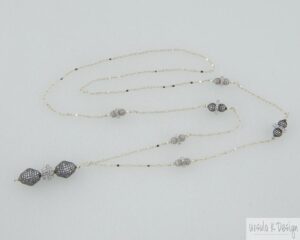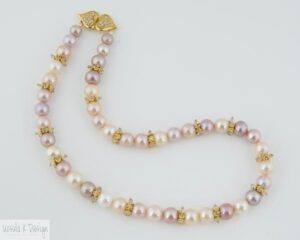More About Rhodium and Cultured Pearls
Welcome to the Ursula K Design blog! Be sure to continue checking back in the future for more information about pearl jewelry, interesting facts about jewelry design, and other insights into the world of custom handmade jewelry! When you shop Ursula K Design’s selection, you’ll have access to a wide variety of pieces handmade by Ursula. Looking for something specific for a gift for a special someone, or to wear during one of life’s special occasions? Get in touch today to request custom, high-quality jewelry.
In this month’s post, learn a little more about the history of rhodium jewelry and cultured pearls from Ursula!
 Rhodium: What Is It, and Why Is It So Valuable?
Rhodium: What Is It, and Why Is It So Valuable?
When I ask most people if they know what rhodium is, they often are not entirely sure. I am sure they’ve heard of rhodium-plated chains — chains that look almost like silver, but not quite! They also probably know that something coated by rhodium never tarnishes, which is why rhodium-plated pieces are so desirable. Be assured that when you have or buy something plated with rhodium, you have a very, very high-quality piece.
Imagine that you were trying to buy an ounce of rhodium, thinking it is likely that it would be a lot cheaper than buying an ounce of gold. Well, in today’s market, you would be paying at least $20,000 for one ounce of rhodium — you read that right, that’s not a mistake —$20,000 for one ounce of rhodium! Now, when I order rhodium-plated chains from a long-time supplier, I have to pay at least 25% extra per gram because the price of this metal has increased by so much. In comparison, if you were curious, gold sells for less than $1,900 per ounce currently.
You might ask why the price of rhodium is so high. Rhodium, which is a noble metal like gold and a part of the platinum family, is actually a by-product of platinum and is mainly used in catalytic converters in cars. Right now, there is only so much rhodium around and there is very little new production happening. If platinum is not mined, there is no rhodium, and as a result, rhodium has become very scarce. So, it follows that since rhodium is rare and many people are chasing it, the price has gone up astronomically!
Now that you know more about rhodium than you ever thought you would, let’s learn a little about another topic in the jewelry world — cultured pearls.
A Word about Cultured Pearls
Over the years, I have been asked many times: are cultured pearls really “real” pearls? I answer that question with a question myself: is a steak really beef if the slaughtered cow was raised by a farmer in a barn, or is it only a steak if the cow was born in the wild and roamed about the prairie until it was caught and slaughtered?
Most everyone would say that beef from a farm-raised cow is not any different than beef from a “wild” cow. It’s the same concept when it comes to pearls! Cultured pearls are produced by oysters or mollusks that have first been carefully raised by “pearl farmers”, who then insert an irritant into the oyster’s or mollusk’s mantle in order to stimulate the production of a pearl.
The oysters and mollusks are truly cared for by the pearl farmer — they are kept in water that is the perfect temperature at the perfect depth, natural enemies are kept away, they are cleaned from time to time to remove debris and fouling organisms, and are thus maintained to assure sufficient nacre accumulation. All of that is really not so different from what the farmer does to raise his cattle until they are ready to send to market. The only difference is that for oysters or mollusks in the wild, the irritant is haphazardly introduced.
When Japanese entrepreneur Kokichi Mikimoto first introduced his cultured pearls to the world in the 1930s, the pearl market crashed because his pearls were less expensive than the natural pearls on the market at that time. The European Pearl Syndicate actually sued Mikimoto, charging that his pearls were fake. Several well-known scientists at the time, however, testified that the Mikimoto pearls were as real as the natural ones brought up from the ocean depth by divers, stating, “the only difference between cultured and natural pearls was that the nucleus was artificially, rather than accidentally, introduced.”
Pearls have been treasured and worn as jewelry by people for thousands of years. At points in the past, you had to be very rich to be able to afford a necklace of beautiful large pearls. Now, thanks to pearl farmers, a string of pearls is within reach of any of us!
Visit the Ursula K Design Store for Handcrafted Artisan Jewelry!
Whether you’re looking for rhodium-plated jewelry, pearl necklaces and earrings, or other one-of-a-kind pieces of jewelry for a special event or a special someone, visit the Ursula K Design store to find pieces to cherish at prices accessible to everyone.
And, be sure to keep checking back in with the Ursula K Design blog for more interesting information about the ins-and-outs of the world of handcrafted jewelry!

